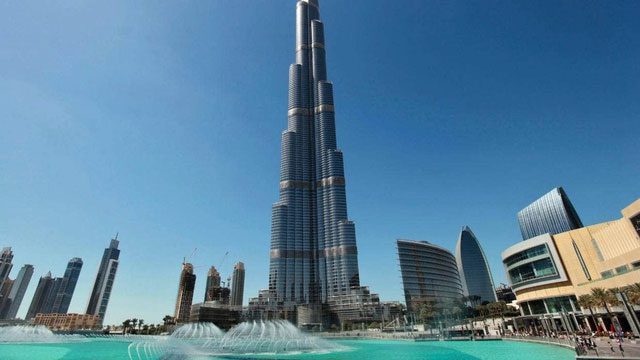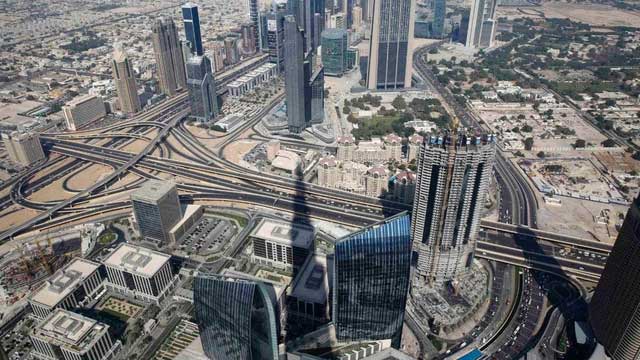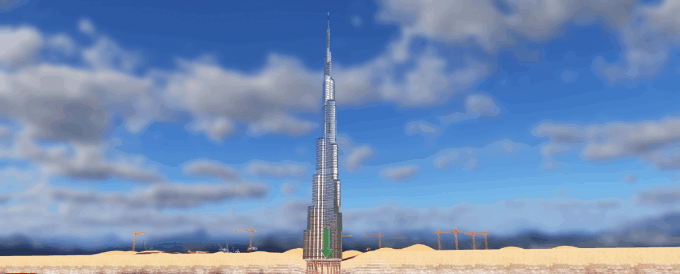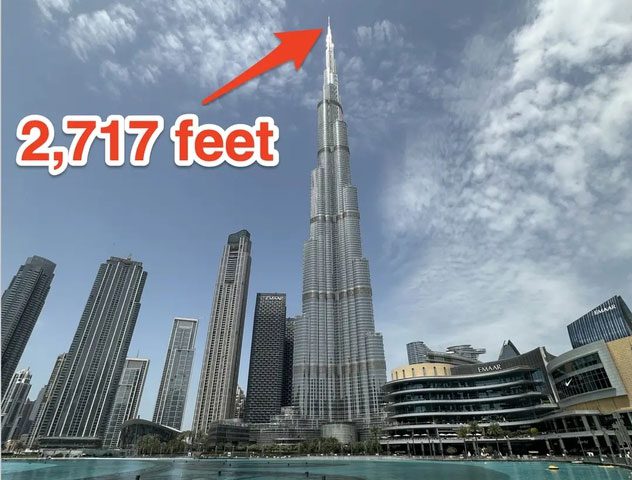It turns out that the tallest building in the world can withstand winds of up to 240 km/h thanks to a special component. What is it?
With a total height of 828 meters, Burj Khalifa (Dubai) is the tallest man-made structure ever built. This building is twice the height of New York’s Empire State Building and three times that of the Eiffel Tower in Paris. Additionally, Burj Khalifa holds several world records, such as having the highest observation deck and the highest swimming pool in a building.
So, how can Burj Khalifa stand firm in sandstorms with winds reaching 240 km/h?

Burj Khalifa is currently the tallest building in the world. (Photo: Reuters).
According to experts, the secret lies in the foundation of the building. This underground structure reaches a depth of 48 meters, equivalent to a 10-story building. Surprisingly, the foundation of Burj Khalifa must be continuously powered 24/7. Any small issue with the electricity could weaken the foundation and potentially lead to disaster during strong winds.
The foundation of Burj Khalifa has a thickness of about 3.7 meters. While it may seem simple, constructing it was no easy task. The main reason was the massive amount of concrete that needed to be poured at once.
Building the Foundation of the Tallest Building in the World Faced Many Challenges

Aerial view of Dubai from Burj Khalifa, the tallest building in the world. (Photo: Reuters).
Specifically, the construction of the foundation began with placing rebar. The next step was pouring concrete. This was a difficult task given the 40-degree heat in Dubai. This is also why engineers and workers had to perform this work at night. They mixed the concrete with blocks of ice during the pouring process. The entire foundation was poured in four separate sections, each taking 24 hours.
Additionally, the foundation construction presented numerous challenges for Mr. Bill Baker, the chief design engineer of Burj Khalifa. First, experts had to tackle the biggest challenge, which was soil settlement. In conventional construction, engineers always find a solid strata where the building can sit.
However, during the construction phase, the weight of the building increases and settling by a few centimeters is normal. During this process, the soil beneath the foundation gets compressed and settles. At this point, the soil can generate a suitable reaction force to balance the weight of the building. However, experts warn that this settlement must remain within safe limits.
Meanwhile, the soil in Dubai is characterized by loose sand and weak sedimentary rock. Even after digging down 140 meters, engineers still could not find solid strata here. Therefore, if the engineers of Burj Khalifa were to use a conventional foundation at this site, it would settle significantly, leading to disaster.
To address this challenge, chief engineer Bill Baker proposed a straightforward solution: using the friction of the surrounding soil. He tried driving a pointed stick into the sand and observed that, upon reaching a certain depth, the stick could not go any further. This was due to the increased frictional force produced by the surrounding sand as the stick was driven down.
Therefore, to create friction, this engineer added piles beneath the foundation. The depth of these piles was equivalent to 10 stories of Burj Khalifa. As a result, when Burj Khalifa was completed, the building’s settlement was only about 5 cm, which is quite safe.

After completion, Burj Khalifa settled only 5 cm. (Image taken from video).
The next significant challenge was how to optimally construct these piles and realize this design. Accordingly, to build these piles, the project team used an excavator with a drilling attachment. This device effectively removed the soil, but engineer Baker faced a major issue with Dubai’s groundwater.
Due to the heavy machinery around, the drilled hole would collapse and fill with saline groundwater. The solution was clear. When digging, workers poured a drilling fluid into the hole. This created a thick slurry mixture, denser than water. This mixture produced hydrostatic pressure on the walls of the hole, preventing soil collapse.
After digging the hole, workers inserted a temporary hollow steel casing to keep the soil intact for the concrete pouring process. They then placed reinforced steel bars welded together like a pillar. Concrete would be poured in with the help of a submerged concrete pipe.
According to experts, just the foundation construction of Burj Khalifa took up to 2 years.
While the foundation helps resist gravity, the strong sandstorms of Dubai present another challenge. The pile foundation design would not withstand strong sandstorms. So, what is the optimal solution that helps this building withstand sandstorms?
In the original design of Burj Khalifa, engineers implemented a solution that enables this massive structure to withstand sandstorms: increasing the number of piles in the foundation. This clever adjustment allows Burj Khalifa to endure wind speeds of up to 240 km/h.
Why does Burj Khalifa’s foundation need to be continuously powered?
The Foundation of Burj Khalifa Requires Continuous Power Supply

Burj Khalifa stands at 2717 feet (approximately 828 m). (Photo: Insider).
Experts explain that continuous power is necessary to prevent seawater from seeping in, which would corrode the rebar inside the piles.
To address this issue, engineers applied a principle similar to that of a battery, known as electrolysis. They turned the rebar into a cathode and used a titanium mesh as an anode. When a direct current from a rectifier is applied between them, electrons deposit at the cathode. This helps prevent corrosion of the rebar but severely degrades the metal at the anode. Therefore, after a few years, the anode needs to be replaced. The proposed solution is that to completely prevent corrosion, an optimal amount of electricity must be supplied.
The Burj Khalifa is recognized not only for its exquisite architecture but also for its many outstanding designs. This structure is considered a distinctive symbol of a luxurious, glamorous city like Dubai.


















































